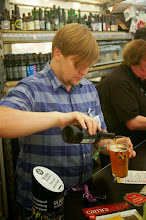The recipe was almost as described in the last blog - I cut the amber back a bit to less than 5% to make sure the final beer wouldn't be too dark:
8kg Pale Malt (Crisp)
400g Amber Malt
Mash at 64/65C for 90 mins with 24l Campden-treated water (I don't do water chemistry yet!)
This was quite a thick mash, but my mash tun couldn't take any more water.
 |
| Two very different amber malts |
So, we made a snap decision to drain the tun without sparging, boil up anything we ran off along with some Fuggles hops that had been hanging around for ages, pitch the backup sachet of dried yeast I keep in case of emergencies, and start again. Using a Scotch Ale as a basic direction, we collected just over 20 litres of deep brown wort, gave it a short 45-minute boil with 50g Fuggles, then ran it off, took a gravity of 1.080 and pitched rehydrated Mauribrew 514 yeast. For an old sachet of dried yeast, it's done a good job - after 3 days, it was down to 1.028, and it's still going.
 |
| Hop soup - with the pellers now in sludgy suspension |
 |
| 300g Dextrose Monohydrate |
On the 26th, 60 hours after pitching, I took the first gravity reading at 1.030 - incredible work from the WLP007 to chew through that much so quickly - and pitched the slurry from the WLP099 starter, along with 400g dextrose monohydrate. I've measured the remaining 3.6kg of the dextrose into 300g and 150g freezer bags, and the plan is to add all of this to the FV over the next few days to give me an adjusted OG of somewhere around the 1.200 mark.
The routine goes like this - I keep a bucket of sanitiser next to the FV containing two jugs, a silicone whisk, my hydrometer and my baster. Twice a day, I take the two jugs out, drain them both back into the bucket, put the whisk and the drained baster in one jug so that they're handy. I then take a sample for the hydrometer and record the gravity, then pour this into the other jug and continue to draw beer from the FV until I have about half a litre in the jug. I add in 300g of dextrose from one of the freezer bags, whisk it into the beer until foamy and in solution, then pour it into the FV and seal it up again. I then clean all the equipment and put it back into the sanitiser.
 |
| Whisking in the dextrose |
I'm hoping to keep the OG somewhere around or just under the 1.030 mark - if I take a gravity reading and the yeast hasn't chewed up all 300g of the dextrose from the previous addition, I'll switch to adding the 150g bags.
So far, it seems to be turning out very nicely! I reckon the ABV is up around the 13% mark by now, and the aroma from the FV is wonderful. My main concern is that during one of the dextrose additions, I'll introduce an infection of some kind, hence the sanitising routine each time I open it up. It's been hard work having to nurture it for as long as I have so far, but I hope it'll be worth it. I'll be back with an update once I've finished the primary fermentation and the beer is ready to enjoy a nice, mellowing rest in secondary for a few weeks.
















